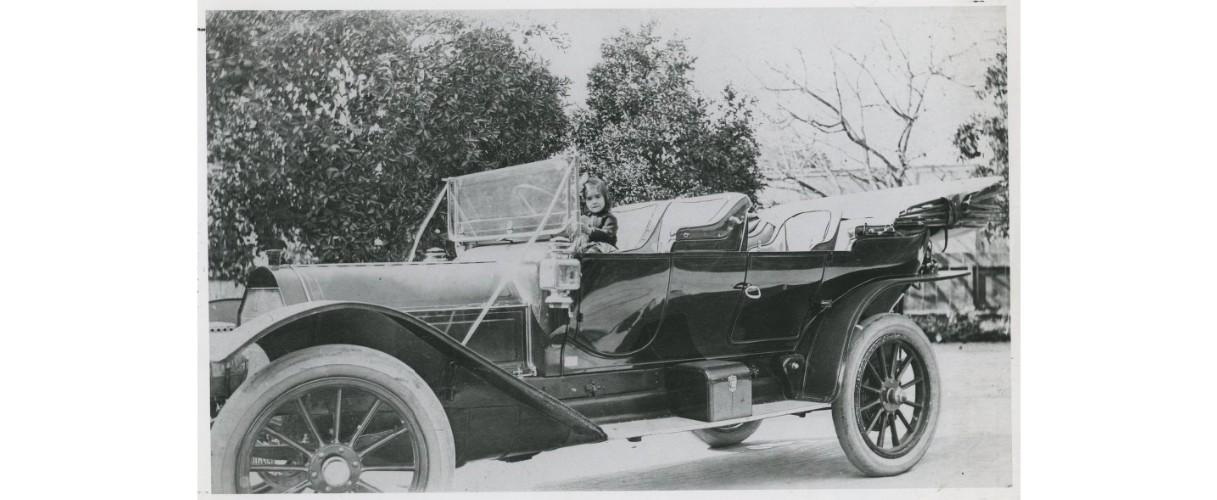- Home
- About Us
- Join/Renew
- Member Benefits
- Member Pages
- Log In
- Help
- Museum Store

I recently received the photo above with an inquiry for information from Stephan Lindsay, a historian working on history related to the Aluminum Company of America (ALCOA), regarding an early Pierce-Arrow Touring car. Bill Scorah was able to identify the car as a 1911 48 SS Protected Touring (has front doors) from the photo that was provided. I was able to locate the car in the Weis files and it is indeed a 1911 48 SS Touring, Serial Number 8710. The car was purchased new in 1911 or 12 by Charles Martin Hall. There is no record of the car still existing.
Mr. Lindsay has provided additional historical information below;
“Charles Martin Hall developed the process to refine aluminum economically and was a co-founder of the Pittsburg Reduction Company. The Pittsburgh Reduction Company [PRC], the forerunner of ALCOA, began production of primary aluminum in 1895 at the first of three production sites that were eventually built in Niagara Falls. The PRC was the first customer of hydroelectric power at the falls. Some remnants of the early PRC buildings remain on the site of the Washington Mills facility just off of Buffalo Avenue. However, even the employees who are now there did not know this until I had a chance, business encounter with Washington Mills about one year ago. The PRC changed its name to the Aluminum Company of America [A.C.O.A.] on January 1, 1907.
The first two Alcoa sites were co-located upstream, about 1.3 miles from where Charles Martin Hall lived near the rapids on the American side of the falls. The third and largest plant was in the Mills area of Niagara Falls just to the north of where the approach to the Rainbow International Bridge now stands, about 0.7 miles from Hall’s home. Production at all three sites finished in the 1920’s and there is little that remains now.
Charles Martin Hall lived in Niagara Falls, NY from 1895 until the time of his passing at the end of 1914. He stayed in boarding houses until 1902 and then bought his first house at 136 Buffalo Avenue. He often walked to work or used a bicycle that he enjoyed riding. He purchased his first automobile, a large, shiny Packard in 1907 and took on a chauffeur, Mr. William Davidson, who had been an electrician at the aluminum plant.
During late-1911 and early-1912 he wintered in Pasadena, CA for the weather and had his Packard shipped with him to the west coast. Before his return to Niagara Falls in the spring of 1912 he sold the Packard.
At some time during 1911 or early 1912 he sold his first home and moved across the street to 131 Buffalo Avenue in order to be closer to the sight and sound of the rapids. Neither of these residences remain. The first residence is now the location of a Holiday Inn and the second is the location of the Parkway Condominiums near the headwaters of the Niagara Rapids.
With the Pierce Arrow plant being so close to the first, truly large aluminum production facility in the world it’s interesting to think about how the commercial and technical decisions must have been made to use aluminum castings and sheet in Pierce-Arrow automobiles. When aluminum was a commercially new metal there were no uses for it. As the company grew beyond fledgling status it had to work furiously to find new applications for lightweight metal, often using it as a substitute for other metals and materials. Although the Wright flyer had used an engine block cast of PRC aluminum I was not aware until receiving your email that castings had also been used for Pierce Arrows.”
Pierce-Arrow was a large user of aluminum, particularly in its car bodies and it is likely that they purchased aluminum from ALCOA. Early Pierce-Arrows used cast aluminum bodies (up to 1920) and then switched to sheet aluminum over wood frame until 1928. Aluminum was also used in crankcases and transmission cases.
In the 1920s, ALCOA constructed around seven special aluminum cars, made with up to 80% aluminum. Some of these were based on Series 80 Pierce-Arrows. (See Arrow 69-4) One of these cars is known to exist and is currently at the Henry Ford.

Great info Dave. Thanks.
Jane –
This post is a reminder of the length of Bernie’s article about Alcoa’s work with Pierce-Arrow (Arrow Series 69-Model 4). At the end he mentioned there could be more information somewhere but said he had exhausted Alcoa’s records. Some time later, I found out the Historical Society of Western Pennsylvania in Pittsburgh had some files on this, including additional photos of the two experimental models. Others might enjoy seeing what is there today.
What seems especially interesting is the two all-aluminum models – one a club sedan, one a three-window sedan/limousine – were on a 133-inch wheelbase chassis. That is the same length as the smaller line of 1929 models, so these cars could have helped develop that, although the pronounced sun visor highlights influencing Series 81 exterior design.
Brooks
Thanks Brooks. I have forwarded the information you provided on the historian that is doing the research. Dave
